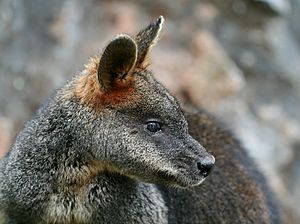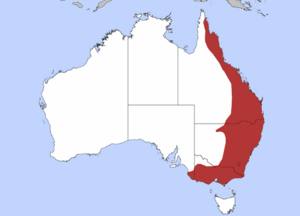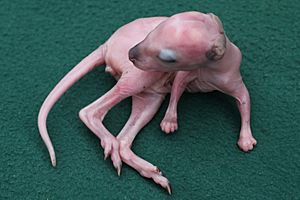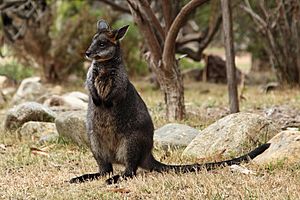Swamp wallaby facts for kids
Quick facts for kids Swamp wallaby |
|
|---|---|
 |
|
| Conservation status | |
| Scientific classification | |
| Genus: |
Wallabia
|
| Species: |
bicolor
|
 |
|
| Swamp wallaby range | |
The swamp wallaby (Wallabia bicolor) is a small marsupial that lives in eastern Australia. It belongs to a group of animals called macropods, which includes kangaroos and other wallabies.
This wallaby is also known by other names like the black wallaby or black-tailed wallaby. Some people call it the stinker because it has a special smell, especially in swampy areas where it lives. The swamp wallaby is the only living animal in its group, called Wallabia.
Contents
Where Swamp Wallabies Live
Swamp wallabies can be found all along the east coast of Australia. They live from the very north of Cape York Peninsula in Queensland, down through New South Wales, and into southwestern Victoria. They used to live in southeastern South Australia, but they are not common there anymore.
These wallabies like to live in thick bushes and trees in forests and woodlands. During the day, they hide in tall grass or ferns. At night, they come out to find food. They especially like areas with thick brigalow scrub in Queensland.
What Does a Swamp Wallaby Look Like?
The swamp wallaby's scientific name, bicolor, means "two colors". This is because it has a special mix of colors. Its back is usually dark brown to black, while its chest is light yellow or orange. It often has a light stripe on its cheek. Its arms, legs, and tail are usually darker, but the very tip of its tail is often white.
Swamp wallabies move differently from other wallabies. They carry their head low to the ground and their tail straight out behind them when they hop.
Male swamp wallabies are about 76 centimeters (30 inches) long, not counting their tail. Females are a bit smaller, around 70 centimeters (28 inches). Their tail is usually about the same length as their body. Males weigh about 17 kilograms (37 pounds), and females weigh around 13 kilograms (29 pounds).
Life Cycle and Reproduction
Swamp wallabies can start having babies when they are about 15 to 18 months old. They can have babies at any time of the year. A baby wallaby grows inside its mother for about 33 to 38 days. Usually, only one baby is born at a time.
The baby, called a joey, stays in its mother's pouch for 8 to 9 months. Even after it leaves the pouch, it will continue to drink milk from its mother until it is about 15 months old.
Swamp wallabies have a very interesting way of having babies. Unlike most other marsupials, a female swamp wallaby can get pregnant again just before her first baby is born. This means she can be pregnant with two babies at once! One baby is almost ready to be born, and a new tiny embryo is just starting to grow. Because of this, female swamp wallabies are almost always pregnant during their adult lives.
What Do Swamp Wallabies Eat?
Swamp wallabies usually like to be by themselves. However, they sometimes gather in groups when they are eating. They eat many different kinds of plants, depending on what is available. This includes shrubs, grass, and even crops from farms. They can eat both native plants and plants that have been brought from other places.
Interestingly, swamp wallabies can eat some plants that are poisonous to many other animals. These include bracken ferns, hemlock, and lantana.
Their favorite foods seem to be shrubs and bushes, which they browse on. This is different from most other wallabies, which usually prefer to graze on grasses. Their teeth are shaped to help them cut through tough plant material.
Swamp wallabies are also known to be opportunists. This means they will eat whatever food they can find, like fungi, tree bark, and even algae. There has even been one report of a swamp wallaby eating meat from a dead animal.
Some Aboriginal people from the Bundjalung Nation did not eat swamp wallabies. They said the wallabies smelled and tasted bad after cooking. Hunters also do not like to hunt them because they are small and their fur is coarse.
Special Features
The swamp wallaby is unique enough that it has its own special group, or genus, called Wallabia. Scientists are still studying their genes. Some studies suggest that Wallabia might actually be part of the larger group Macropus, which includes many kangaroos and wallabies. This means their classification might change in the future.
See also
 In Spanish: Walabí de pantano para niños
In Spanish: Walabí de pantano para niños





